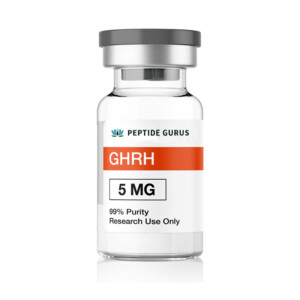Growth Hormone – Releasing Hormone (GHRH) is a naturally occurring peptide. It is released by the arcuate neurons in the hypothalamus. This peptide then travels to the pituitary gland. Once there, it binds to the growth hormone – releasing hormone receptor. As a result, it causes the release of growth hormone (GH). GHRH plays a crucial role in proper growth and development. It increases lean body mass and reduces adiposity (fat tissue). Additionally, it has been found to have some effects on pain relief.
Research on GHRH and Pain Relief
Research in rats has shown promising results regarding GHRH’s potential for pain relief. Specifically, it has been found to be effective in relieving inflammatory pain. What’s interesting is that GHRH reduces pain without affecting the inflammatory mediators that cause it. This characteristic is clinically relevant. It gives doctors the ability to fine – tune an inflammatory response. They can reduce pain without impacting other important aspects, such as the presence of nerve growth factor.
Of particular interest is the role of GHRH in fibromyalgia. Fibromyalgia is a complex condition. It is associated with widespread pain, fatigue, and sleep disturbance. Scientists have long known that exercise can have a significant and lasting impact on fibromyalgia pain. This led them to believe that GHRH or GH deficiency may play a role in the development of fibromyalgia. Administration of GHRH has been shown to reduce pain in this condition. It may also help re – establish normal sleep cycles. Currently, treatments for fibromyalgia are relatively limited in efficacy. So, the use of GHRH to treat fibromyalgia could potentially be a significant breakthrough.
FDA Guidelines Related to Peptide Drugs
The FDA has issued guidelines for peptide drug products. These guidelines are aimed at helping the industry develop such products. They cover various clinical pharmacology considerations. This includes factors like liver injury, drug – drug interactions (DDI), QTc interval lengthening risk, and immunogenicity risk. These factors can impact the pharmacokinetics (PK), safety, and effectiveness of peptide drugs.
When developing a proposed peptide drug product, companies need to take these guidelines into account. They must ensure that the product’s development, including aspects related to dosage, administration, and safety, complies with the FDA’s requirements. For GHRH peptide, this means that any product on the market should have undergone proper testing to assess its safety and effectiveness in pain relief, while also considering potential interactions with other medications and effects on different body systems as per FDA guidelines.
Dosage and Administration
The recommended dosage can vary depending on the patient. For adult patients of standard weight, the content of one ampoule of GHRH (such as GHRH Ferring with 50 micrograms of Somatorelin) is dissolved in 1 ml of the supplied solvent. This solution is then administered intravenously as a bolus injection. In cases of highly overweight adult patients and children, a dosage of 1 microgram per kg body weight is indicated.
For diagnostic purposes, like the GHRH test, the process is as follows. First, approximately 2ml of venous blood is withdrawn from a fasted patient. Then, a single intravenous injection of the GHRH product is given. The increase in basal growth hormone levels in plasma or serum after this injection is measured. To do this, the content of one ampoule is dissolved in 1 ml of solvent (0.9% NaCl). Or, if appropriate, a volume corresponding to 1 microgram per kg body weight is administered intravenously to the fasted patient as a bolus injection (within 30 seconds). To evaluate the growth hormone increment in plasma or serum, a second blood sample is taken 30 minutes after the injection. However, peak growth hormone values may occur sooner or later. So, additional blood samples may be taken at 15, 45, 60, and 90 minutes after GHRH injection for a more accurate assessment of growth hormone release.
Common Questions and Answers
Question: Can GHRH peptide be used to treat all types of pain?
Answer: Currently, research mainly shows its potential in relieving inflammatory pain, especially in conditions like fibromyalgia. There isn’t enough evidence yet to suggest it can treat all types of pain. More studies are needed to determine its effectiveness in other pain conditions.
Question: Are there any side effects of using GHRH peptide for pain relief?
Answer: As with any medication, there can be potential side effects. Some possible side effects may include injection – site reactions. Also, since it affects the body’s hormonal system, there could be impacts on other hormonal functions. However, more research is still being done to fully understand all the potential side effects. It’s important to consult a healthcare provider before using it.
Question: How long does it take for GHRH peptide to start working for pain relief?
Answer: The time it takes to start working can vary from person to person. In some cases, especially in research on conditions like fibromyalgia, some patients may start to notice a reduction in pain within a few weeks of consistent use. But individual response times can depend on factors such as the severity of the pain condition and the individual’s body’s response to the peptide.
